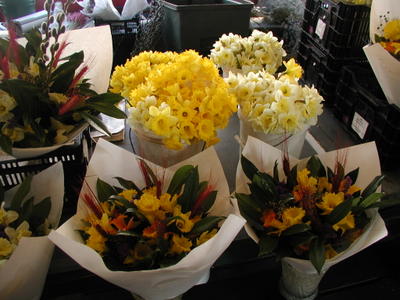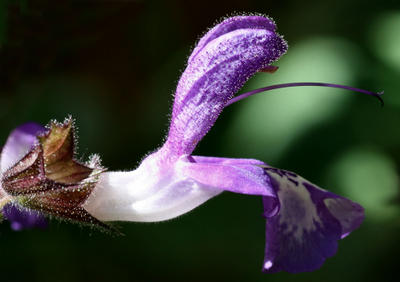 My Home Farmer's Market
My Home Farmer's MarketI'm a huge fan of Farmer's Markets. I like to check out the local ones wherever my travels take me. The all time most amazing Farmer's Market in the world, Pike Place Market, is in Seattle and close enough to visit whenever the mood strikes. But there is nothing like my "Home" market, the one held here in the town where I live. The first day the market opens in April is my personal bookmark for the real start of spring and the last day of the market in October is always the first day of my winter. But right now, in high summer, the market is a blast of color, life, and activity that gives the weekend a great start and provides the rest of the week with the fresh tastes of summer fruits and vegetables and the brilliant flashes of color from fresh flowers.
My Home Market is held every Saturday morning from 8:00 AM to 2:00 PM on one of the original homestead farms here - some of the vendors are arrayed outside the old barn; others are rowed up inside along the sides of the dairy barn. I buy from many of the vendors every week; I know many of them by name as we've made acquintance and become weekend friends over the years. The cookie lady has my slice of lemon pound cake waiting for me now and Garden Barb usually has a salvia plant or some other plant that's interesting and needing a home as well. My amigo Tobias and his family have the *best* fruits and veggies. We gripe about the weather and marvel at the bounty of the harvest. He tells me about the new varieties of fruits and veggies he's planted this year as I pick through boxes of produce in his stand and pay for them. He's one of the hardest working guys I know but he always laughs as he throws in an extra ear of corn or a peach for me.
 One of the great joys of living in the Puget Sound area is the number of flower vendors at any of the farmer's markets around here. There are usually at least four or five of them - with buckets and buckets of flowers - all picked earlier the morning of the market. The vendors spend all day making the most amazing bouquets, rubber banding bundles of stems as big as their wrists together, wrapping each one in a cone of white butcher paper and setting it in a bucket of water, tempting each passerby with the sheer joy of life. The mildness of our maritime climate means the bouquets are inexpensively priced: ten dollars purchases a merely large and lovely one and fifteen bucks will get you a huge and astounding one. It's always a tough decision which vendor has the best flowers and bouquets every week but the smiling little vietnamese grandma and her teenaged grandkids usually manage to fill my house with color from their garden.
One of the great joys of living in the Puget Sound area is the number of flower vendors at any of the farmer's markets around here. There are usually at least four or five of them - with buckets and buckets of flowers - all picked earlier the morning of the market. The vendors spend all day making the most amazing bouquets, rubber banding bundles of stems as big as their wrists together, wrapping each one in a cone of white butcher paper and setting it in a bucket of water, tempting each passerby with the sheer joy of life. The mildness of our maritime climate means the bouquets are inexpensively priced: ten dollars purchases a merely large and lovely one and fifteen bucks will get you a huge and astounding one. It's always a tough decision which vendor has the best flowers and bouquets every week but the smiling little vietnamese grandma and her teenaged grandkids usually manage to fill my house with color from their garden.In addition to the master gardners always on hand to help with questions about your own gardens, there are the other regular plant vendors - some of them specializing in veggie starts, or tomatos or annuals or trees. One of my favorite plantswomen at the market is the tiny, elderly woman who is there every week selling houseplants, the occasional lily, rose or rhododendron, sea shells, polished stones and small cachepots all planted and ready to take home. I hope I have as much energy and vitality as she when I reach her age.
There are some other regular vendors I don't know so well. Some of them are there each week, but one needs only so many pot holders, pillows, jewelry, wooden cooking utensils or any of a raft of other handmade things. Then there are the food stands: Tamales, chinese/thai dishes, hot dogs & brats, and the Cadillac Bar-B-Que, along with cookies, popcorn, struedels, bread, honey, pasta and dip mixes, rubs and bar-b-que sauces, nuts and the occasional one week pleasure of salsa, sweet potato pie, or pickled carrots. The regular folks who serve lunch (Tamales, chinese/thai, and Cadillac Bar-B-Que) have been interesting to watch. In the years that I've been going to the market, they've all started small, and have outlasted the others, building up a loyal customer base and gradually expanding their menu lists. All of it is served and consumed outdoors - sun or cloud, rain or shine - which makes it all taste better, of course. Added to the pleasure of the food is the joy of live music - usually about 3 times a month with Gospel choirs, Kodo Japanese drum groups, English brass bands, folk guitarists, and many more making the air vibrate with sound and grace.
Others vendors are more intermittent - coming perhaps for a few days at the beginning of the season, or once every few weeks, or even a single day each summer. Most of the berry vendors are there only when their berries are in season - first Ranier and Bing cherries, then raspberries and strawberries, then on into blueberries and finally blackberries and marionberries. Pear and Apple vendors tend to star showing up later in the season as their produce ripens as well. Each week they each all get a look - one can never tell what new delights might show up.
Three times each season during the run of my Home market, they have kid's day. After attending an evening class on the basics of buying and selling, farmer's market style, kids of any age are allowed to set up as vendors and sell stuff they make: pillows, beaded necklaces, eyeglass holders, crayon drawings, lemonade, dog biscuits, sugar cookies, cupcakes, clay sculptures, decorated candles, tye-died t-shirts, or whatever they want to try their hand at selling. These days are always a ton of fun: the kids are anxious to sell, the parents are having fun with it, and there are always the interesting transactions that happen when kids find themselves dealing with adults as equals. Today, one of the kids was a 8 year old girl selling tiny clay sculptures of animals and people made of brightly colored baked modeling clay. She had cats, dogs, pigs, cows, an entire dragon family (dad, mom, kids and uncle) and a farmer. Her parents looked on as we had a very interesting chat on how she made her scupltures, how long it took to make them, and whether her tiny hands and fingers gave her an advantage in making them over someone with very big hands like mine. After careful inspection of each of her pieces, I finally decided I needed one of her Siamese cats (perhaps an inch tall, with a white body, blue eyes, and black face, ears, legs and tail) and $3.00 moved from big hands into small, nimble ones with smiles on both sides.
Some of the kids do quite well with this start in business. Last year, an older boy, perhaps fourteen or so, started selling small jars of homemade jams. He began with about six varieties or so, selling them on a one day lark. However, his jams and jellys and preserves proved popular and the farmer's market bug must have bit him because this year he's a regular each week, selling a dozen or so varieties, all made the previous week from fresh market fruit. At $3.00 each, they're sunshine in a four ounce jar for your morning toast and a great way to stretch the 6 days til the next farmer's market.












